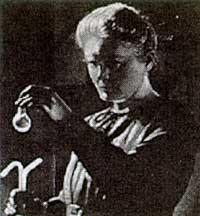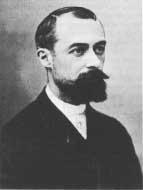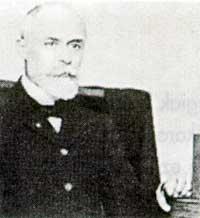Curie, Marie (Marie Sklodowska)
1995/08/02 Azkune Mendia, Iñaki - Elhuyar Fundazioa | Kaltzada, Pili - Elhuyar Zientziaren Komunikazioa
(1867-1934)
Marie Sklodowska was born in Vart?on November 7, 1867. His father was professor of physics and his mother was director of a girls' college. The young Marie had bad luck in her youth. On the one hand, his mother died tuberculosis and, on the other, his father was left without work.

Then, Marie could not do higher studies in Poland and took another path. His older brothers and sisters went to study in Paris. To help them and that by the way he also joined Paris, Marie worked. He also learns on his own until 1891, when he moves to Paris. There he studied in the Sorbonne posing a great hunger. Once in class the hunger fell dizzy. However, when Marie finished her studies, she was already the best student of the class.
In 1894 he met the chemist Pierre Curie. Pierre was already well known for having studied piezoelectricity for the first time. In 1895 they married.
Roentgen and Becquerel discovered the discoveries of X-rays and radiations of uranium and Marie began to study these phenomena.
She investigated the radiations of uranium and used piezoelectricity found by her husband to measure radiations.
In 1898 he showed that the chemical thorium was a radioactive element. At the same time, when he was measuring the radioactivity of the different uranium minerals, he saw zero: some minerals were much more radioactive than others.
Pierre Curie then abandoned his research to help his wife. In 1898 the marriage had already isolated a small uranium powder a hundred times more radioactive. He was baptized as Polonio in honor of Marie's hometown.
At the end of 1898 a more radioactive substance was found. This graft was detected as an impurity with the name of Radio. However, for the collection of large amounts of radio, it was necessary to bring mineral from Czechoslovakia. The mine owners gave them free what they wanted, but transportation to France was paid for marriage with money anticipated during their lifetime. For four years the tonne was dedicated to cleaning and enriching the mineral until in 1902 a tenth of a gram of Radio was prepared.
In 1903 Marie Curie wrote her doctoral thesis, which earned her the Nobel Prize with her husband and Becquerel.
In 1906 Pierre Curie died and Marie obtained the chair of the Sorbonne. There she was the first woman to exercise as a teacher. At the French Academy, however, she was rejected for being a woman.
In 1911 he was awarded the Nobel Prize in Chemistry for finding two new elements, only to him.
The Polish Marie Sklodowska died of leukemia in 1934 due undoubtedly to the prolongation of the Sabon under radiation in Garaia.

Gai honi buruzko eduki gehiago
Elhuyarrek garatutako teknologia






